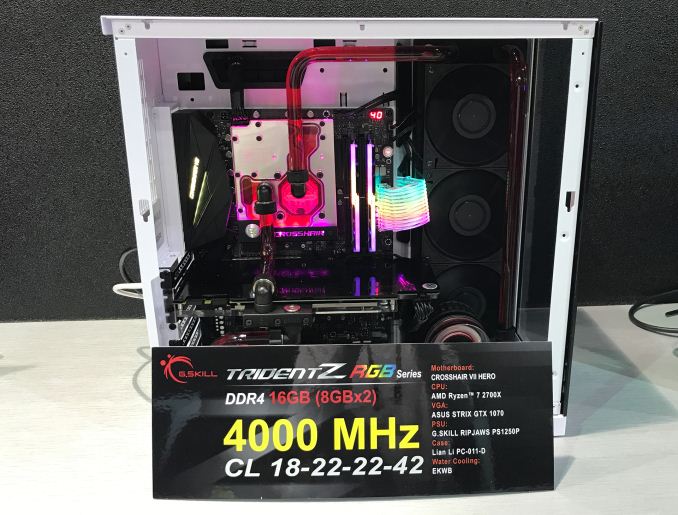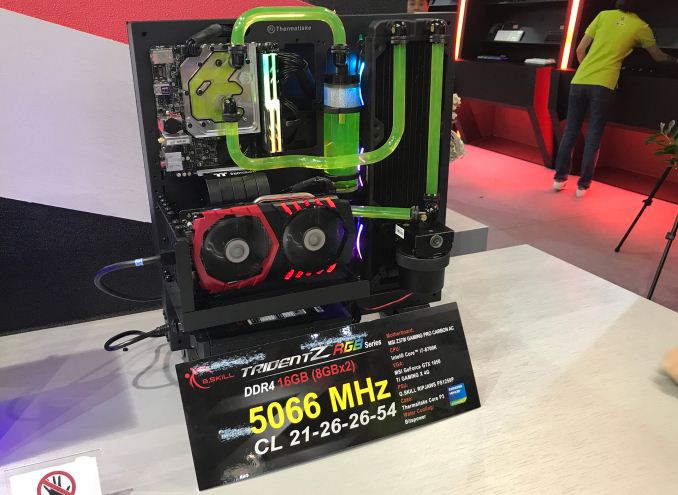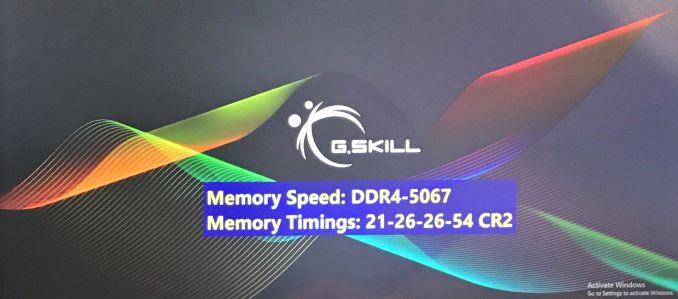G.Skill’s DRAM Extremes: DDR4-4000 on AMD Ryzen, DDR4-5066 on Intel Core i7
by Anton Shilov on June 11, 2018 2:00 PM EST- Posted in
- Memory
- G.Skill
- DDR4
- Trident Z
- Ryzen
- Coffee Lake
- Computex 2018

In the constant race to one-up the other memory vendors in the highly commoditized DRAM market, at Computex last week G.Skill demonstrated its Trident Z RGB memory modules running at rather unprecedented data transfer rates. While operating DDR4 at 5000 MT/s in dual-channel mode is not considered a breakthrough these days, running memory at 4000 MT/s on an AMD Ryzen system is something rather unique.
One of the peculiarities that AMD’s first-gen Ryzen platform has is a memory sub-system that cannot handle data rates significantly higher than 3200 ~ 3466 MT/s. With the second-gen Ryzen platform AMD partially fixed the problem by altering the caching sub-system and upgrading firmware, yet without actually changing the memory controller. Therefore, running memory at high frequencies is still a challenge with the Ryzen 2000-series.
Nonetheless, as the things are getting better, companies like G.Skill can push DDR4 modules all the way to 4000 MT/s with CL18 22-22-42 timings on a Ryzen 7 2700X CPU, as well as with CL20 22-22-44 on a Ryzen 5 2600 processor. Obviously, DDR4 memory modules have to use 1.35 V at high speeds, but G.Skill has not specified voltage for the memory kits in question.
Without any doubts, it has taken G.Skill quite some time to figure out precise sub-timings for a DDR4-4000 operation on a Ryzen 2000-series/X470 platform. Moreover, the company is only demonstrating two dual-channel 16 GB kits, so some luck with the modules and the processors may be involved. Meanwhile, it is also worth mentioning that G.Skill supplies memory for AMD’s Ryzen review kits sent to journalists and other partners of AMD, so it gets to spend more time tweaking SPD settings for AMD Ryzen systems than any other supplier of memory modules.
Intel’s memory controllers and memory sub-systems on the latest platforms have their perks, but G.Skill has a lot of experience with Intel’s CPUs in general. Therefore, it was not surprising to see that the company could hit DDR4-5066 with its latest Trident Z RGB memory modules albeit with very loose CL21 26-26-54 timings at a high voltage.
Obviously, Computex demonstrations do not necessarily indicate imminent product launches. Nonetheless, if G.Skill can hit certain data transfer rates with hand-picked DIMMs, it learns what is needed to replicate the same settings in mass products. The only question is when such products become available and at how high their prices are going to be.
| Want to keep up to date with all of our Computex 2018 Coverage? | ||||||
 Laptops |
 Hardware |
 Chips |
||||
| Follow AnandTech's breaking news here! | ||||||














18 Comments
View All Comments
peevee - Monday, June 11, 2018 - link
"CL21 26-26-54"The game is old.
Von Neumann is dead.
rahvin - Monday, June 11, 2018 - link
With latencies that high (21-26-26-54) you have to wonder if it's even faster at all.edzieba - Monday, June 11, 2018 - link
Remember CAS latencies are not absolute, they're measured in clock cycles. e.g. CL21 at 5066MHz is equivalent to CL10 at 2400MHz.StevoLincolnite - Monday, June 11, 2018 - link
Common DDR5, where arth thou?Alexvrb - Monday, June 11, 2018 - link
We know Ryzen scales with speed and latency, speeding up the IF is crucial. But how much does Coffee Lake really benefit when you start going over ~3600 into the "holy crap that's expensive" RAM territory? I mean given the price premium it seems like it would only make sense after you've already bought the highest end CFL chip you can lay your hands on.Dragonstongue - Monday, June 11, 2018 - link
IMO is for the benchmark champions, not real world use, at least I cannot think of one, when the latency mucks up the bandwidth available it becomes not really worth it for much of anything else.There might be a very small handful of games, pro apps, workstation stuff etc that really cares about raw bandwidth over snappy latency, but most times it is the other way around, which is why it seems to be DDR2 at 800, DDR3 at 1600-1866, DDR4 at 2600-3200 (with latencies to match the speed such as CL5 for the 800, CL 7-9 for the 1600 and CL 14-18..subtimings are important as well)
Kalelovil - Monday, June 11, 2018 - link
IIRC Ryzen doesn't run IF any faster above DDR4-3200.alex-w - Tuesday, June 12, 2018 - link
I've got G-Skill memories running at DDR4-3466 with G.Skill Trident Z 2x8GB CL16 and Asus Crosshair VI Hero and Ryzen 1700. It refused to work at that speeds, but after a BIOS update around the launch of R2 series it does.Alexvrb - Tuesday, June 12, 2018 - link
Whether or not you'll see performance benefits past X frequency is very different from whether or not it continues to run faster. I've seen memory scaling tests that show Ryzen still scaling the same all the way up to 3466. Other configs may continue to demonstrate good scaling beyond that point... again depends on the software and where the bottleneck lies.PixyMisa - Tuesday, June 12, 2018 - link
Still two years away, most likely.